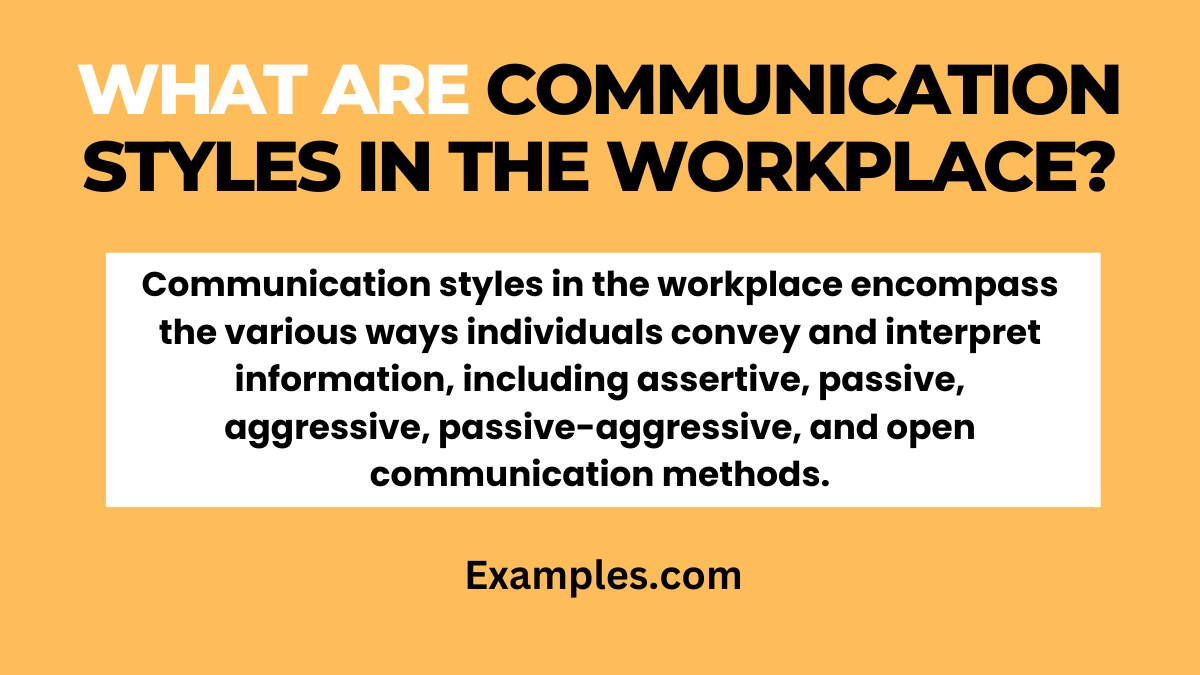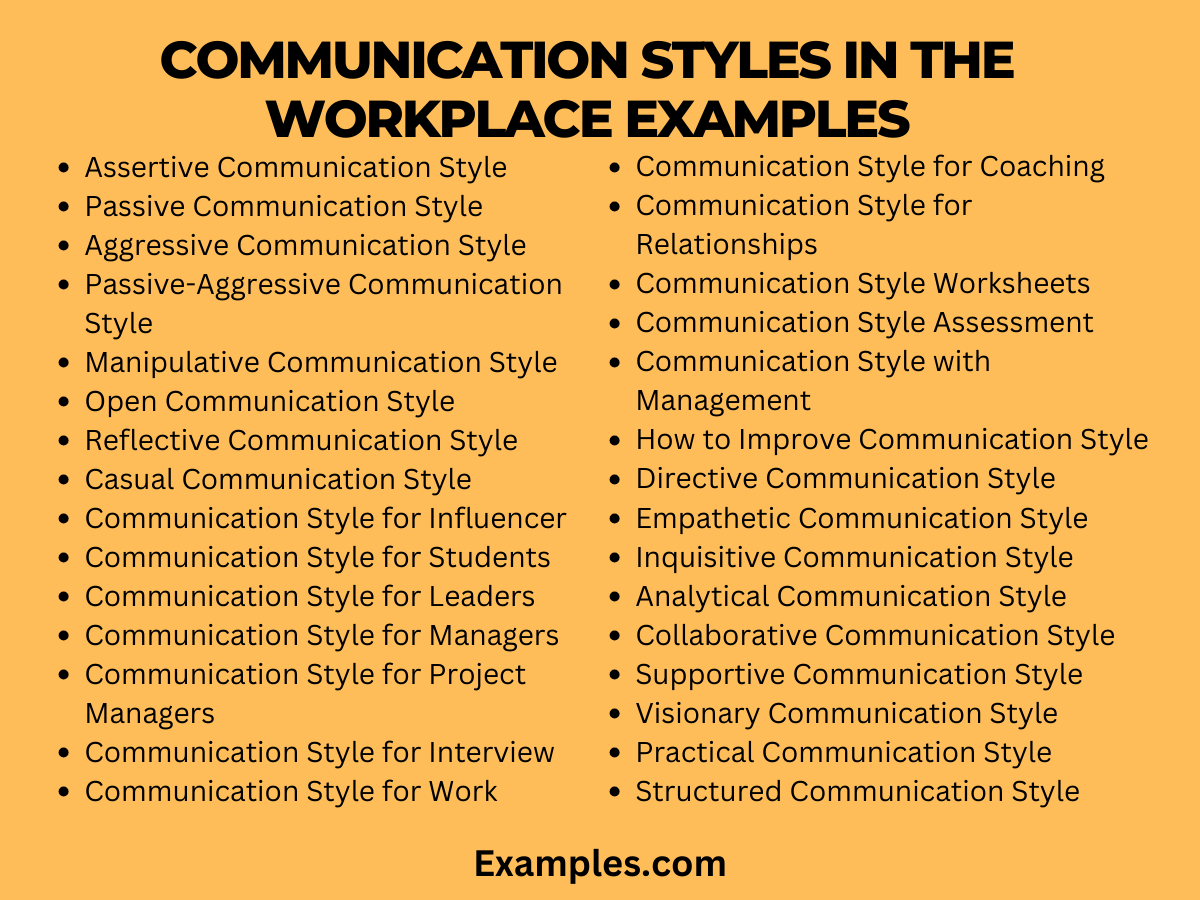29+ Communication Styles in the Workplace Examples
Navigating the diverse landscape of Communication Styles in the Workplace is crucial for professional success. This comprehensive guide delves into various communication methods, from assertive to passive, and their impact on teamwork and leadership. With practical Communication Objective Examples, you’ll learn how to adapt and excel in any work setting. Whether you’re a manager, team member, or leader, these insights and examples will empower you to communicate effectively and achieve your professional goals.
What are Communication Styles in the Workplace?

Communication styles in the workplace refer to the various ways individuals express themselves and interact with others professionally. These styles encompass how we share information, respond to feedback, and engage in discussions. The Assertive Communication Style is direct and clear, ensuring messages are understood without being aggressive. In contrast, a Passive Communication Style might involve more listening than speaking, often leading to a lack of direct communication. Understanding these styles, such as the Open Communication Style or the Reflective Communication Style, is key to fostering effective collaboration and a harmonious work environment. Each style has its strengths and challenges, and recognizing them can greatly enhance workplace interactions and productivity.
Communication Styles in the Workplace Examples
Understanding the diverse range of Communication Styles in the Workplace is essential for fostering a productive and positive work environment. These styles influence how we interact with colleagues, approach tasks, and resolve conflicts. This guide provides 30 distinct examples, each with a unique approach and practical sentences for effective workplace communication. From the Assertive Communication Style to the more Casual Communication Style, mastering these styles can lead to better teamwork, enhanced leadership skills, and improved workplace dynamics.

- Assertive Communication Style: This style involves expressing your thoughts clearly and respectfully.
Example: “I believe our project would benefit from a revised strategy. Let’s discuss potential improvements.” - Passive Communication Style: Often involves indirect expression of thoughts or needs.
Example: “I’m okay with any decision the team makes, but perhaps we could consider another approach.” - Aggressive Communication Style: Characterized by dominating conversations.
Example: “This is the only way to do it, and we must follow my lead!” - Passive-Aggressive Communication Style: Involves indirect expression of discontent.
Example: “Fine, we’ll do it your way, but don’t be surprised if it doesn’t work out.” - Manipulative Communication Style: Uses subtle tactics to influence others.
Example: “If you take on this project, it will show management how committed you are.” - Open Communication Style: Involves sharing thoughts and feelings honestly.
Example: “I want to openly discuss our project challenges to find the best solution.” - Reflective Communication Style: Focuses on active listening and understanding.
Example: “I hear your concerns about the deadline, and I understand why it’s stressful.” - Casual Communication Style: Relaxed and informal in approach.
Example: “Hey team, let’s quickly chat about our project progress.” - Communication Style for Influencer: Involves inspiring and motivating others.
Example: “Your innovative ideas can really drive our project’s success!” - Communication Style for Students: Encourages learning and growth.
Example: “Let’s explore new ways to approach this problem and learn from the process.” - Communication Style for Leaders: Involves guiding and directing a team.
Example: “As we move forward, let’s focus on our key objectives and collaborate effectively.” - Communication Style for Managers: Balances directing tasks and supporting team members.
Example: “I’ll provide the resources you need, but I trust your judgment on this project.” - Communication Style for Project Managers: Focuses on clear instructions and team coordination.
Example: “Let’s review the project plan to ensure everyone is on the same page.” - Communication Style for Interview: Balances professionalism with showcasing personality.
Example: “I am passionate about my work and eager to contribute to your team’s success.” - Communication Style for Work: Adapts to various professional scenarios.
Example: “In this meeting, let’s be concise and focus on actionable steps.” - Communication Style for Coaching: Involves offering guidance and support.
Example: “Consider these strategies to enhance your performance in this area.” - Communication Style for Relationships: Focuses on empathy and understanding in professional relationships.
Example: “I value your perspective and would like to understand your viewpoint better.” - Communication Style Worksheets: Utilizes structured exercises for communication improvement.
Example: “Let’s use this worksheet to identify our communication strengths and areas for growth.” - Communication Style Assessment: Involves evaluating personal and others’ communication styles.
Example: “Through this assessment, we can better understand how to communicate effectively as a team.” - Communication Style with Management: Tailored to effectively convey messages to higher-ups.
Example: “I have prepared a concise report on our project’s progress for management review.” - How to Improve Communication Style: Involves actively working on enhancing one’s communication approach.
Example: “I am practicing active listening to better understand team needs and respond effectively.” - Directive Communication Style: Involves giving clear, specific instructions.
Example: “Please complete the report by Friday, and ensure all data points are accurately represented.” - Empathetic Communication Style: Focuses on understanding and addressing others’ feelings.
Example: “I understand that this task is challenging, let’s work together to find a solution.” - Inquisitive Communication Style: Involves asking questions to gain deeper insights.
Example: “Can you explain how this process will benefit our project?” - Analytical Communication Style: Relies on data and facts for decision-making.
Example: “Based on our data analysis, this strategy seems most effective.” - Collaborative Communication Style: Encourages teamwork and collective problem-solving.
Example: “Let’s brainstorm together to find the best approach for this challenge.” - Supportive Communication Style: Involves offering encouragement and positive reinforcement.
Example: “You’re doing great work on this project, keep it up!” - Visionary Communication Style: Involves sharing a compelling vision or idea.
Example: “Imagine the impact our project could have if we succeed in this area.” - Practical Communication Style: Focuses on straightforward, practical solutions.
Example: “Let’s focus on the most feasible solution given our current resources.” - Structured Communication Style: Involves organized and methodical communication.
Example: “In our meeting, let’s follow the agenda to cover all important points.”
5 Types of Communication Styles in the Workplace
Understanding the variety of Communication Styles in the Workplace is crucial for creating an effective and harmonious work environment. Here are five key types of communication styles commonly observed in professional settings:
- Assertive Communication Style: This style is characterized by clarity, directness, and respect. Assertive communicators express their thoughts and needs confidently while respecting others, making it an ideal Communication Style for Leaders and Communication Style for Managers.
- Passive Communication Style: Individuals with this style tend to be more reserved and may not openly express their thoughts or feelings. This can lead to misunderstandings in the workplace, contrasting the Open Communication Style which promotes transparency.
- Aggressive Communication Style: This style is marked by dominance and often involves speaking in a loud and demanding manner. It can create a tense atmosphere, differing from the Reflective Communication Style, which focuses on understanding and empathy.
- Passive-Aggressive Communication Style: This indirect style can manifest through sarcasm or backhanded comments. It hinders straightforward communication, which is essential in roles like Communication Style for Project Managers.
- Manipulative Communication Style: Involves subtle control or emotional deception. This style can be harmful to workplace trust and teamwork, contrasting with the Communication Style for Coaching, which is meant to uplift and support.
Each of these styles plays a significant role in workplace interactions. Recognizing and adapting these styles can lead to better communication, improved team dynamics, and enhanced overall productivity.
Importance of Communication Styles in the Workplace
The importance of mastering Communication Styles in the Workplace cannot be overstated. Effective communication is the cornerstone of successful team interactions, leadership, and overall workplace harmony. Here’s why understanding and adapting these styles is crucial:
- Enhances Team Collaboration: Effective communication styles, like the Assertive Communication Style or Open Communication Style, foster better collaboration and understanding among team members.
- Improves Conflict Resolution: Recognizing and adjusting communication styles can significantly aid in resolving workplace conflicts. A Reflective Communication Style can be particularly effective in understanding different perspectives.
- Boosts Leadership and Management Efficiency: For leaders and managers, adopting a suitable communication style, such as the Communication Style for Leaders, is key to guiding teams and managing tasks effectively.
- Facilitates Employee Engagement: Engaged employees are more productive and committed. An Empathetic Communication Style can greatly enhance employee engagement and job satisfaction.
- Promotes a Positive Workplace Culture: A healthy work environment is built on clear and respectful communication. Styles like the Casual Communication Style can contribute to a more relaxed and positive atmosphere.
- Aids in Personal and Professional Development: Understanding and adapting one’s communication style, as emphasized in Communication Style Worksheets and Communication Style Assessment, is vital for personal growth and career advancement.
In essence, the effective use of communication styles in the workplace leads to improved interactions, stronger relationships, and a more productive work environment. Adapting these styles to suit various professional scenarios, such as a Communication Style for Interview or Communication Style for Work, is key to professional success
Mastering various Communication Styles in the Workplace is vital for professional success. From assertive to reflective styles, effective communication fosters teamwork, resolves conflicts, and enhances leadership. This guide provides essential insights and practical tips to navigate workplace interactions skillfully. Embracing these styles leads to a more harmonious, productive work environment and paves the way for personal and professional growth.



